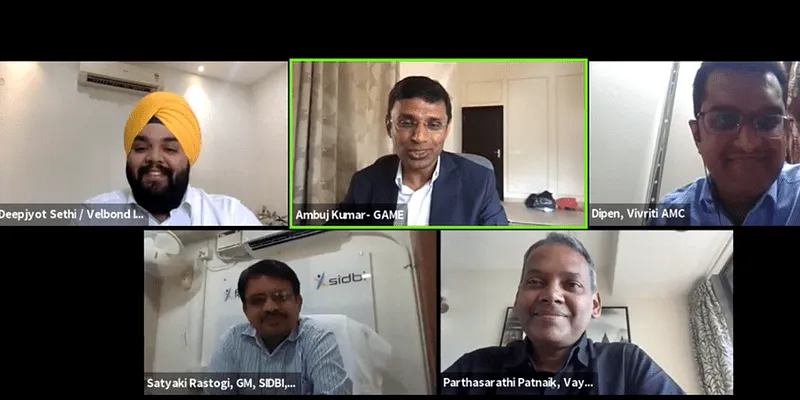How new-age developments are overcoming barriers for MSME lending
Speaking at TechSparks 2021, Parthasarthi Patnaik, Chief Credit and Risk Officer, Vayana Network; Deepjyot Sethi, Partner, Velbond Industries; and Satyaki Rastogi, General Manager, SIDBI; spoke about the way forward for MSME lending and how new-age developments will bring new opportunities.
Only 16 percent of the debt market in the MSME space is formal. About 30 out of 10,000 NBFCs/fintech account for 80 percent of bank sectoral exposure, said Ambuj Kumar, Advisor at Global Alliance for Mass Entrepreneurship (GAME).
Access to finance among MSMEs is one of the biggest challenges for them to grow and scale. At YourStory’s flagship event, TechSparks 2021, Ambuj spoke to Parthasarthi Patnaik, Chief Credit and Risk Officer, Vayana Network; Deepjyot Sethi, Partner, Velbond Industries; Dipen Ruparalia, Head, Product, & Fund Structuring, Vivriti Asset Management; and Satyaki Rastogi, General Manager, SIDBI, about the various challenges faced by the MSME sector in terms of receiving credit, and how new-age developments are helping these traditional businesses.
What does it take to amplify innovative solutions?
For MSMEs, the biggest challenge is being unaware of schemes and funds that are available for them due to which their goals are hammered.
“There are so many strong and mind-blowing ideas from entrepreneurs in small cities, but lack of awareness of the availability of funds and various schemes hinder them from spreading their wings,” said Deepjyot.
Besides these, the cumbersome banking processes and collaterals lower the morale of entrepreneurs.
Parthasarthi also spoke about the problem faced by lenders and said that a lending institution is also a business that has to be profitable. The trust deficit for small businesses makes these institutions demand a security (collateral), which is an efficient approach. However, he also highlighted that as digitisation has grown among all sectors and with the implementation of GST, the data now accessible to the lenders helps them be the decision makers at many points of lending to an MSME.
With the implementation of GST, lenders can now get access to GST data to monitor the business health of an MSME. However, there is no standard mechanism for the same. Parthasarthi said that at Vayana, they will work with CRIF, an RBI approved credit bureau, to create a Good Business Score (GPS) for MSMEs where, through their consent, GST data for a specified period is pulled out, which can help these enterprises get their business scores and help them borrow better.
“Once this GST score (GPS) gets popular in the sector, it will become equivalent to our bureau score. However, it will take time to get seeded into the ecosystem,” he added.

Asset Management Companies
Dipen said, according to an IFC report, the credit gap between demand and supply for an MSME is extremely wide, around Rs 25 lakh crore. He added that banks are the major lenders, contributing to about 80 percent of lending to MSMEs. However, this process is cumbersome for any MSME. NBFCs also borrow from banks to lend to these enterprises, and even though NBFCs contribute a smaller share, the process of loan disbursement takes around three days.
“But NBFCs face their own challenges in taking credit from banks as they have certain rules and regulations to comply with and this is where an Asset Management Company shapes up as an alternate way of sourcing. We create a capital market for these digital NBFCs.”
Dipen said that banks are potential investors in terms of Alternative Investment Funds (AIF), but there are precarious regulations on banks if they lend to any AIF.
“AIF is a five lakh crore industry and this is growing very fast. Alternative Investment Managers like us see this as an opportunity for MSME funding,” he said.
Collaborative approach will help MSMEs
“We have to create an ecosystem where these traditional lenders reach out to AIFs or fintechs with low cost funds built on the models that individual banks would develop. I feel they should reach businesses with new ideas through AIF and traditional businesses through fintechs. That is where the cost of borrowing for these fintech and AIFs would be lower. This will help in overall cost of funds delivery to MSMEs much better,” says Satyaki.
On final thoughts, the panel said there is no dearth of capital in the market, but a proper knowledge and awareness is needed by MSMEs to avail and utilise the capital to the best of their abilities.
Developing a proper model is the need of the hour for banks to lend to AIFs and fintechs, which have a huge potential and are the last mile in MSME lending.

Edited by Megha Reddy








